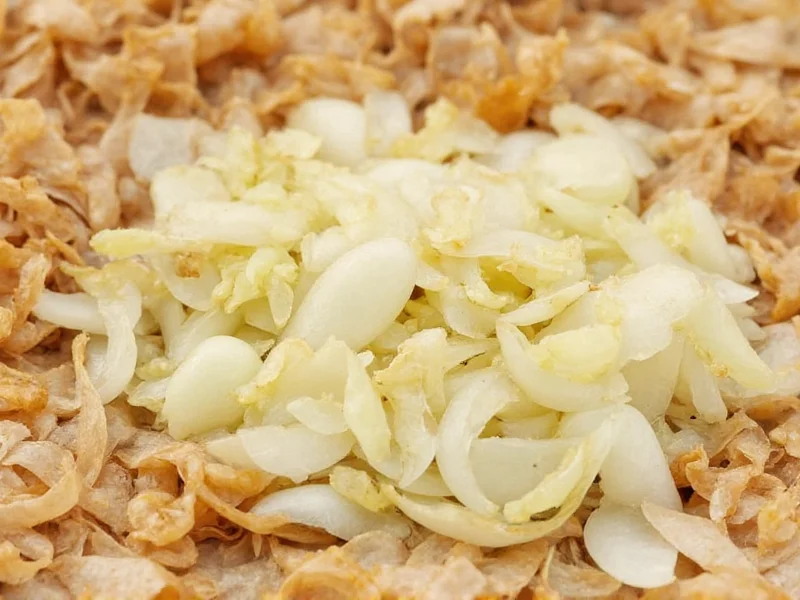Understanding proper onion substitutions is essential for consistent cooking results. When fresh onions aren't available, dried chopped onions provide a convenient alternative, but their concentrated flavor requires careful measurement to avoid overpowering your dishes. This guide explains the precise conversions, flavor considerations, and best practices for substituting dried for fresh onions in your recipes.
Why Onion Conversion Ratios Matter
Dried chopped onions undergo a dehydration process that removes approximately 85-90% of their water content. This concentration means dried onions deliver more intense flavor in a smaller volume. Using improper measurements can lead to dishes that are either bland or overwhelmingly onion-flavored. The standard conversion accounts for this concentration difference while maintaining balanced flavor profiles.
Complete Dried Chopped Onion Conversion Chart
| Dried Chopped Onions | Fresh Chopped Onions Equivalent | Common Recipe Application |
|---|---|---|
| 1 teaspoon | 1 tablespoon | Seasoning blends, spice rubs |
| 1 tablespoon | 1/4 cup (4 tablespoons) | Most standard recipes |
| 2 tablespoons | 1/2 cup | Soups, stews, sauces |
| 1/4 cup | 1 cup | Casseroles, meatloaf, large batches |
| 1/3 cup | 1 1/3 cups | Substantial dishes requiring strong flavor |
Flavor Differences Between Dried and Fresh Onions
While the 1:4 ratio provides a good starting point for dried chopped onion equivalent measurements, understanding flavor differences helps refine your substitutions. Dried onions develop slightly sweeter, more concentrated flavors during dehydration, with less sharpness than fresh onions. They lack the moisture that contributes to texture in dishes, which affects how they integrate into sauces and baked goods.
For recipes where texture matters—like fresh salsas or salads—dried onions won't provide the same mouthfeel as fresh. However, in cooked applications like soups, stews, and braises, properly rehydrated dried onions can deliver comparable flavor results.
Best Practices for Substituting Dried for Fresh Onions
Follow these professional kitchen techniques when using dried chopped onions as a fresh onion substitute:
- Rehydrate for optimal results: Combine dried onions with 2-3 times their volume in warm water or broth and let sit for 10-15 minutes before adding to recipes
- Adjust seasoning timing: Add dried onions earlier in the cooking process to allow full flavor development
- Consider recipe moisture content: In low-liquid recipes, increase liquid by 1-2 tablespoons per 1/4 cup of dried onions used
- Taste and adjust: Always taste before final seasoning, as dried onions may require additional balancing with acid or sweetness
- Storage awareness: Dried onions maintain potency for 12-18 months when stored in airtight containers away from light and moisture
Special Considerations for Specific Recipes
Certain dishes require customized approaches when substituting dried for fresh onions:
Baking Applications
For breads, biscuits, and savory baked goods, use a 1:3 ratio instead of 1:4. The baking process concentrates flavors further, so slightly less dried onion prevents overpowering results. Rehydration isn't necessary in high-moisture doughs.
Raw Applications
Dried onions don't work well in completely raw applications like fresh salsas or salads. For these, consider using a small amount of onion powder (1/4 teaspoon powder = 1/4 cup fresh) for subtle flavor without texture issues.
Slow Cooking
In crock pot recipes, use the standard 1:4 ratio but add dried onions during the last hour of cooking. Extended cooking can make dried onions develop bitter notes.
Common Mistakes to Avoid
Many home cooks make these errors when substituting dried for fresh onions:
- Using equal measurements without conversion
- Adding dried onions directly to dry spice rubs without rehydration
- Not accounting for the salt content in some commercial dried onion products
- Using dried onions in recipes specifically designed for fresh onion texture
- Storing dried onions near strong-smelling spices, which they readily absorb
When Fresh Onions Are Truly Necessary
While dried chopped onions work well in many applications, certain recipes genuinely require fresh onions for proper results. These include:
- Fresh salsas and pico de gallo
- Ceviche and other raw fish preparations
- Onion rings and fried onion dishes
- Caramelized onions where texture development matters
- Recipes specifically highlighting raw onion crunch
Understanding these limitations helps you make informed decisions about when substitution works and when it's better to seek fresh alternatives.
What is the exact dried chopped onion equivalent for 1 cup fresh onions?
One cup of fresh chopped onions equals approximately 4 tablespoons (1/4 cup) of dried chopped onions. This 4:1 ratio (fresh to dried) accounts for the water removal during dehydration while maintaining proper flavor balance in most cooked dishes.
Can I use dried minced onions instead of onion powder?
While both are dehydrated onion products, they're not direct substitutes. Dried minced onions have texture and rehydrate differently than onion powder. Use 3 tablespoons dried minced onions for every 1 tablespoon onion powder, or 1 tablespoon onion powder for every 1/4 cup dried minced onions, depending on your recipe's moisture needs.
How do I properly rehydrate dried chopped onions?
Combine dried onions with 2-3 times their volume in warm water, broth, or recipe liquid. Let sit for 10-15 minutes until fully expanded. For best results, use the rehydration liquid in your recipe to capture all flavor compounds. Avoid using boiling water, which can create uneven texture.
Why does my dish taste too strong when using dried onions?
This typically happens when using equal measurements instead of following the proper 1:4 conversion ratio. Dried onions are more concentrated, so using the same volume as fresh creates overpowering flavor. Start with less than the standard conversion (try 1:5 ratio) and adjust to taste, especially with stronger onion varieties like red onions.
How long do dried chopped onions last compared to fresh?
Properly stored in an airtight container away from light and moisture, dried chopped onions maintain best flavor for 12-18 months. Fresh onions last 1-2 months in cool, dark storage. The shelf life advantage makes dried onions practical for infrequent cooks, though fresh onions provide superior texture in raw applications.











 浙公网安备
33010002000092号
浙公网安备
33010002000092号 浙B2-20120091-4
浙B2-20120091-4